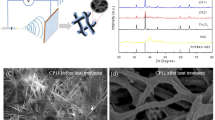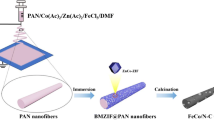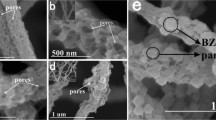Abstract
Developing highly active and low-cost catalysts towards oxygen evolution reaction (OER) is of high importance for many advanced energy technologies, e.g., rechargeable fuel cells, metal-air batteries, water and splitting. In this work, Co3O4 nanofibers are prepared through a facile pyrolizing procedure by using cobalt complex nanofibers as the precursor. The catalyst exhibits high performance towards OER in 1 M KOH solution, with potentials of 1.53 and 1.59 V at 10 and 100 mA cm−2, respectively. When used as the air electrode catalyst combining with Pt/C catalyst, it can give the zinc-air battery a high charging performance, as well as an outstanding cyclic charging-discharging stability.
Similar content being viewed by others
Avoid common mistakes on your manuscript.
Introduction
Oxygen evolution reaction (OER) is a key process in many advanced energy technologies, e.g., rechargeable fuel cells [1], metal-air batteries [2,3,4,5,6], and water splitting [7,8,9,10]. Due to its sluggish kinetic procedures, highly active catalysts are required. Although noble metals like Ir and Ru, including their oxides, are the state-of-art catalysts for OER [11,12,13,14], their scarcity and high cost have seriously hampered their commercial applications. Thus, developing highly active and low-cost OER catalysts becomes rather important for the large-scale applications of these advanced energy technologies.
Co3O4 has a typical spinel structure, in which the tetrahedral and octahedral positions are occupied by Co2+ and Co3+, respectively. The coexistence of Co2+ and Co3+ make Co3O4 more conductive and beneficial to the reversible adsorption of molecular oxygen. Thus, Co3O4 can exhibit relatively high OER performance [7, 15,16,17]. Unfortunately, up to now, Co3O4-based OER catalysts still fail to meet the practical demands of those advanced energy technologies.
Generally, catalysts’ performance can be enhanced by simply reducing their sizes to nanoscale thanks to the enlarged surface areas, the increased exposed active sites, and the improved contact between the catalyst and the support. However, as is well known, nano particles will easily agglomerate due to their high surface energy, which will eventually lead to the dramatic degradation in their catalytic performance. Nanofiberous structures can be attractive due to their inherent anisotropy, high flexibility, and high electrical conductivity. Compared with nano particles, nanofibers can avoid aggregation and maintain high surface areas effectively during the catalyzing procedures [18,19,20].
Inspired by these factors, nanofiberous Co3O4 will be charming since it combines the advantages of fibrous structures and Co3O4. In this work, we fabricated a nanofibrous Co3O4 catalyst through a facile pyrolizing procedure by using a cobalt complex as the precursor. The catalyst exhibits high performance towards OER in 1 M KOH solution. The OER potentials can be as low as 1.53 and 1.59 V at 10 and 100 mA cm−2, respectively. When used as the air electrode catalyst combining with Pt/C catalyst, it can deliver a zinc-air battery a high charging performance and an outstanding cyclic charging-discharging stability.
Experimental
Preparation of catalysts
The cobalt complex is firstly prepared through a procedure reported in our previous work [21]. Briefly, 7.0 mL CoCl2 solution (0.15 M) and 3 mmol nitrilotriacetic acid are firstly added to 7.0 mL isopropanol (Fig. 1). After stirring for 10 min, the obtained mixture is transferred into an autoclave, which is then sealed and heated at 180 °C for 24 h. After cooling down naturally, the suspension is filtrated, rinsed with deionized water, and dried at 80 °C in a vacuum. The obtained pink powder is named as “NTACo.”
The Co3O4 nanofibers are prepared by pyrolyzing the precursor “NTACo” in air for 3 h under different temperatures, with a heating rate of 2 °C min−1. The obtained final catalysts are named as NTACo-400, NTACo-450, and NTACo-500, respectively, where the numbers stand for the temperatures applied.
Preparation of working electrodes
Five milligram catalyst is homogeneously dispersed in 1.00 mL Nafion ethanol solution (0.25 wt%) under ultrasound for about 30 min. Then, 20 μL of the obtained suspension is coated onto a glassy carbon electrode (GCE, Φ 5 mm) and dried naturally.
Preparation of air electrode
For catalyst layer fabrication, the slurry is firstly prepared by completely mixing NTACo-450 (5.0 mg) and Pt/C catalyst (5.0 mg) in Nafion ethanol solution (0.25 wt%, 2 mL) under ultrasonic. Subsequently, 100 μL of the obtained slurry is painted onto the gas diffusion layer (GDL, SIGRACET) and dried under an infrared lamp. The catalyst loading is calculated to be 0.5 mg cm−2. For comparisons, mixed catalyst of Pt/C and Ir/C (with mass ratio of 1:1) is also used to fabricate a reference air electrode through the same procedures.
Characterization
The scanning electron microscopy (SEM) images are obtained on a JSM-7100F field emission scanning electron microscope (JEOL, Japan), with an acceleration voltage of 5 kV. The transmission electron microscopy (TEM) is operated on a JEM-2100 transmission electron microscope (JEOL, Japan) with an acceleration voltage of 200 kV. The X-ray photoelectron spectroscopy (XPS) is conducted on an ESCALAB 250 X-ray photoelectron spectrometer (Thermo-VG Scientific, USA). The X-ray diffraction (XRD) is conducted on a TD-3500 powder diffractometer (Tongda, China) at a scan rate of 5°min−1.
Electrochemical measurements
Catalysts’ electrochemical performance are evaluated by using a three-electrode glass cell on an Interface 1010B electrochemical workstation (Gamry, USA), coupled with a rotating disk electrode (RDE) system (RDE710, Gamry, USA). During the test, an Hg/HgO/NaOH (1 M) and Pt wire are used as the reference and counter electrodes, respectively. The GCE’s geometric area is calculated to be 0.1964 cm2. And all the potentials initially measured are converted to the ones versus the reversible hydrogen electrode (RHE) by adding 0.92 V.
The linear sweep voltammetry (LSV) measurements are conducted at a scan rate of 5 mV s−1. The i-t curves are recorded at 0.72 V (vs. RHE).
Battery tests
A home-made ZAB device is fabricated for the tests. A 6 M KOH solution containing 0.2 M zinc acetate is used as the electrolyte, and a zinc plate is used as the anode. The cyclic charging-discharging tests are conducted by using galvanostatic technology on a BTS-3000 battery testing system (Newware, China) under the current density of 5 mA cm−2, with a duration time of 20 min for each cycle (10 min for discharging and another 10 min for charging).
Results and discussions
Figure 2 shows the SEM images of the precursor NTACo and the catalysts obtained at different temperatures. It can be seen that NTACo and the obtained catalysts all present nanofiberous morphologies, indicating that this nanofiberous morphology can be well preserved during the heat treatments. At the same time, we also noticed that the three catalysts obtained after heat treatment are composed by numerous nanoparticles, and the nanoparticles in NTACo-500 are significantly larger than those in NTACo-400 and NTACo-450, which can be further confirmed by their TEM images (Fig. 3a–c). Obviously, higher temperature promotes the agglomeration and aging of these nanoparticles.
From the high-resolution TEM (HRTEM) results, one can find that the lattice fringe spacing of the particle in NTACo-450 is about 0.29 nm (Fig. 3d), which can be assigned to the (220) crystal planes of Co3O4, indicating that these particles are Co3O4. Figure 3e–h is the EDS mapping results of NTACo-450. It can be found that Co, O, C, and N are homogeneously distributed in NTACo-450.
From the XRD patterns of the three catalysts (Fig. 4), the diffraction peaks around 19.0, 31.2, 36.8, 38.5, 44.8, 55.6, 59.3, and 65.2 degrees can be observed, which are corresponding to the (111), (220), (311), (222), (400), (331), (422), and (440) facets of Co3O4, indicating the existence of Co3O4 in the three catalysts. And these results are consistent with the HRTEM results.
Figure 5a shows the XPS spectra of NTACo and the catalysts obtained after the heat treatments. No obvious N1s peaks can be observed in the obtained catalysts. Given the surface atomic compositions (Fig. 5b), it can be found that the N contents decrease drastically from 8.3 to 0.6, 0.5, and 0.4 at% for NTACo-400, NTACo-450, and NTACo-500, respectively, suggesting that most of the nitrogenous organic components have been destroyed during the pyrolyzing process.
From the high-resolution Co2p spectrum of NTACo (Fig. 6a), two groups of peaks can be found between 810–793 and 793–775 eV, corresponding to the Co2p1/2 and Co2p3/2, respectively. The fitting results showed that the Co2p3/2 of NTACo can be deconvoluted into three peaks around 780.0, 783.4, and 787.2 eV, which can be assigned to the Co(II)-OCO (carboxyl group), Co(II)-N, and Co satellite peaks, respectively [22]. Similarly, the Co2p1/2 peak can be also deconvoluted.
Figure 6b–d shows the Co2p spectra of the three catalysts. It can be seen that the Co2p spectra of the three catalysts all show two groups of peaks around 795 and 780 eV, which are corresponding to the Co2p1/2 and Co2p3/2, respectively. The fitting results show that the Co2p spectra can be separated into two peaks corresponding to Co3+ (around 794.6 and 779.5 eV) and Co2+ (around 796.5 and 781.2 eV), respectively, indicating that Co3+ and Co2+ coexist in the three catalysts. Considering the atomic compositions (Fig. 6e), it can be found that the NTACo-450 has the highest Co3+ content of 46.1 at% among the three catalysts.
Figure 7a shows the LSV curves of the different catalysts. It can be found that all the three catalysts exhibit high OER catalytic performance, and outperform the Ir/C catalyst, especially at high current density. Among the three catalysts, NTACo-450 has the lowest potentials of 1.53 and 1.59 V (vs. RHE) at 10 and 100 mA cm−2, respectively, indicating that NTACo-450 is the most active among the three catalysts. Figure 7c shows the Tafel slopes. It can be seen that the Tafel slopes of the three catalysts are 64.1, 59.1, and 63.2 mV dec−1, respectively. Obviously, NTACo-450 has the lowest Tafel slope value, indicating that it has the lowest overpotential in catalyzing OER, which further confirms its highest OER performance among the three.
a LSV curves in 1 M KOH solution of obtained catalysts; b OER potentials at 10 and 100 mA cm.−2, respectively; c Tafel curves derived from the LSV curves; d i-t curve of NTACo-450 after a 20,000-s test at 0.72 V (vs. RHE); e charging-discharging curves of ZABs using different air electrode catalysts; f cyclic charging-discharging curves of ZABs using different catalysts
For Co3O4, both Co2+ and Co3+ are regarded as the active sites for OER. However, some recent studies [23] discovered that Co3+ is actually much more active than Co2+. Combining with the XPS results, NTACo-450 has the highest Co3+ content, which should be the proper reason for its highest OER performance among the obtained catalysts.
To evaluate the catalysts’ performance in actual batteries, ZABs are fabricated. As illustrated in Fig. 7e, the ZAB using Pt/C + NTACo-450 composite catalyst exhibits a high current density of 203.4 mA cm−2 at 0.7 V, obviously higher than that of the ZAB using Pt/C + Ir/C catalyst (186.4 mA cm−2). Regarding the charging performance, the ZAB using NTACo-450 can exhibit a rather high current density of 148.4 mA cm−2 at 2.2 V, which is much higher than that of ZAB using Ir/C catalyst (78.2 mA cm−2), suggesting its better charging performances.
Figure 7f demonstrates the cyclic charging-discharging curves of the fabricated ZABs. During the first 100 cycles, the ZABs using Ir/C as the OER catalyst shows a rapid degradation in charging performance, whereas no significant performance decay was found for the one using NTACo-450. After 600 cycles, the ZABs using Pt/C and NTACo can maintain most of its initial performance, suggesting that it has a superior stability to that based on Pt/C and Ir/C.
Conclusion
In summary, a Co3O4 nanofiber is prepared through a facile pyrolizing procedure by using a cobalt complex prepared from cobalt chloride and nitrilotriacetic acid as the precursor. The catalyst exhibits high performance towards OER in 1 M KOH solution, with potentials of 1.53 and 1.59 V at the current densities of 10 and 100 mA cm−2, respectively. Specially, when used as the air electrode catalyst combining with Pt/C catalyst, it can deliver a zinc-air battery an outstanding cyclic charging-discharging stability.
References
Dresp S, Luo F, Schmack R, Kühl S, Gliech M, Strasser P (2016) An efficient bifunctional two-component catalyst for oxygen reduction and oxygen evolution in reversible fuel cells, electrolyzers and rechargeable air electrodes. Energy Environ Sci 9(6):2020–2024
Zhao C-X, Liu J-N, Yao N, Wang J, Ren D, Chen X, Li B-Q, Zhang Q (2021) Can aqueous zinc–air batteries work at sub-zero temperatures? Angew Chem Int Ed 60(28):15281–15285
Zhang Q, Guan J (2021) Applications of Atomically dispersed oxygen reduction catalysts in fuel cells and zinc-air batteries. Energy Environ Mater 4(3):307–335
Wu W, Liu Y, Liu D, Chen W, Song Z, Wang X, Zheng Y, Lu N, Wang C, Mao J, Li Y (2021) Single copper sites dispersed on hierarchically porous carbon for improving oxygen reduction reaction towards zinc-air battery. Nano Res 14(4):998–1003
Sun H, Wang M, Zhang S, Liu S, Shen X, Qian T, Niu X, Xiong J, Yan C (2020) Boosting oxygen dissociation over bimetal sites to facilitate oxygen reduction activity of zinc-air battery. Adv Func Mater 31(4):2006533
Han J, Bao H, Wang J-Q, Zheng L, Sun S, Wang ZL, Sun C (2021) 3D N-doped ordered mesoporous carbon supported single-atom Fe-N-C catalysts with superior performance for oxygen reduction reaction and zinc-air battery. Appl Catal B 280:119411
Yu M, Budiyanto E, Tuysuz H (2022) Principles of water electrolysis and recent progress in cobalt-, nickel-, and iron-based oxides for the oxygen evolution reaction. Angew Chem Int Ed Engl 61(1):e202103824
Liu S, Lin Z, Wan R, Liu Y, Liu Z, Zhang S, Zhang X, Tang Z, Lu X, Tian Y (2021) Cobalt phosphide supported by two-dimensional molybdenum carbide (MXene) for the hydrogen evolution reaction, oxygen evolution reaction, and overall water splitting. J Mater Chem A 9(37):21259–21269
Zhuang L, Jia Y, Liu H, Li Z, Li M, Zhang L, Wang X, Yang D, Zhu Z, Yao X (2020) Sulfur-modified oxygen vacancies in iron–cobalt oxide nanosheets: enabling extremely high activity of the oxygen evolution reaction to achieve the industrial water splitting benchmark. Angew Chem Int Ed 59(34):14664–14670
Jin R, Huang J, Chen G, Chen W, Ouyang B, Chen D, Kan E, Zhu H, Li C, Yang D, Ostrikov K (2020) Water-sprouted, plasma-enhanced Ni-Co phospho-nitride nanosheets boost electrocatalytic hydrogen and oxygen evolution. Chem Eng J 402:126257
You C, Gao X, Wang Q, Li X, Tan S, Xu P, Cai D, Weng Y, Wang C, Tian X, Liao S (2019) Rechargeable zinc–air battery with ultrahigh power density based on uniform N Co codoped carbon nanospheres. ACS Appl Mater Interfaces 11(47):44153–44160
Zhu Y, Yue K, Xia C, Zaman S, Yang H, Wang X, Yan Y, Xia BY (2021) Recent advances on MOF derivatives for non-noble metal oxygen electrocatalysts in zinc-air batteries. Nanomicro Lett 13(1):137
Wu M, Zhang G, Du L, Yang D, Yang H, Sun S (2021) Defect electrocatalysts and alkaline electrolyte membranes in solid-state zinc-air batteries: recent advances, challenges, and future perspectives. Small Methods 5(1):e2000868
Wang SY, Chen SM, Ma LT, Zapien JA (2021) Recent progress in cobalt-based carbon materials as oxygen electrocatalysts for zinc-air battery applications. Mater Today Energy 20:100659
Quast T, Varhade S, Saddeler S, Chen Y-T, Andronescu C, Schulz S, Schuhmann W (2021) Single particle nanoelectrochemistry reveals the catalytic oxygen evolution reaction activity of Co3O4 nanocubes. Angew Chem Int Ed 60(43):23444–23450
Hu Z, Hao L, Quan F, Guo R (2022) Recent developments of Co3O4-based materials as catalysts for the oxygen evolution reaction. Catal Sci Technol 12(2):436–461
Lu Y, Fan D, Chen Z, Xiao W, Cao C, Yang X (2020) Anchoring Co3O4 nanoparticles on MXene for efficient electrocatalytic oxygen evolution. Sci Bull 65(6):460–466
Aljabour A (2020) Long-lasting electrospun Co3O4 nanofibers for electrocatalytic oxygen evolution reaction. Chemistry Select 5(25):7482–7487
Wang Z, Liu H, Ge R, Ren X, Ren J, Yang D, Zhang L, Sun X (2018) Phosphorus-doped Co3O4 nanowire array: a highly efficient bifunctional electrocatalyst for overall water splitting. ACS Catal 8(3):2236–2241
Xu Q-Z, Xu Q-Z, Su Y-Z, Wu H, Cheng H, Hui Y-P, Li N, Liu Z-Q (2014) Effect of morphology of Co3O4 for oxygen evolution reaction in alkaline water electrolysis. Curr Nanosci 11(1):107
Wang Q, Gao X, Li X, You C, Wang C, Liao S (2021) Metallic cobalt encapsulated in N-doped carbon nanowires: a highly active bifunctional catalyst for oxygen reduction and evolution. Ionics 27(8):3501–3509
Li C, Yin X, Chen L, Li Q, Wang T (2010) Synthesis of cobalt ion-based coordination polymer nanowires and their conversion into porous Co3O4 nanowires with good lithium storage properties. Chem Eur J 16(17):5215–5221
Liu Z, Wang G, Zhu X, Wang Y, Zou Y, Zang S, Wang S (2020) Optimal geometrical configuration of cobalt cations in spinel oxides to promote oxygen evolution reaction. Angew Chem 132(12):4766–4772
Funding
This work was supported by the Natural Science Foundation of Hainan Province (project Nos. 221RC540, 219QN206); the National Natural Science Foundation of China (NSFC project nos. 52162027, 21606061, 21805104, 31360069, 21662012, 51663009); the Development Program for Innovative Research Team in Ministry of Education (grant No. IRT-16R19); the Research Project of Hainan Provincial Department of Education (Hnky2017-21); Hainan Provincial Graduate Innovation Research Project (Hyb2020-53, Hys2019-278); the science and technology planning project of Haikou (2016030); and the Research Fund Program of Key Laboratory of Fuel Cell Technology of Guangdong Province.
Author information
Authors and Affiliations
Corresponding authors
Additional information
Publisher's note
Springer Nature remains neutral with regard to jurisdictional claims in published maps and institutional affiliations.
Rights and permissions
About this article
Cite this article
Wang, Q., Wang, X., Wang, C. et al. Co3O4 nanofiber as a high-performance electrocatalyst for oxygen evolution. Ionics 28, 4395–4400 (2022). https://doi.org/10.1007/s11581-022-04644-x
Received:
Revised:
Accepted:
Published:
Issue Date:
DOI: https://doi.org/10.1007/s11581-022-04644-x











